The article below by Hannah Michael Gale Shapero originally appeared in the CAIS website hosted by Shapour Suren-Pahlav in London.

Hannah Michael Gale Shapero is an artist, illustrator and scholar. She was born in Boston, Massachusetts, US and grew up in the Boston area and in Rome, Italy. Shapero studied Classics-Greek and Latin as an undergraduate at Brandeis University and as a graduate at Harvard. She was also active as an artist and writer during that time. In 1978 she left academia for an art career and in 1981 became a professional artist. She has studied art at the Boston University art school but most of her training has been with private teachers, especially her mother.
====================================================================================
The question of whether Zoroastrianism should allow converts is one of the most divisive and bitter issues facing the whole community. While other religions, such as Christianity and Islam, depend on converts to increase their numbers, Zoroastrianism has been, at least in recent centuries, strictly based on ethnicity. You have to be born a Zoroastrian in order to be one; you cannot enter into the faith from outside. But the question is continually asked: why must this be true? Can this policy be changed? And has this always been true in the long history of the faith? In this essay I will try to describe the many problems, arguments, and reasons on both sides of the question.
Can you convert to Zoroastrianism? The official answer, which is given by the Parsi priestly hierarchy in Bombay, and supported by a large number of traditional Zoroastrians, is NO. In order to be a Zoroastrian, you must be born of two Zoroastrian parents. One is not enough! No children of mixed marriages are officially Zoroastrian. In practice, however, the children of Zoroastrian fathers and non-Z. mothers are sometimes given admission to the faith – but not the children of Zoroastrian mothers and non-Z. fathers. Zoroastrian identity descends through the father’s line, unlike Jewish identity, which is defined by the mother being Jewish.
Why has this rule against conversions come about? There are many levels of reasoning behind it. Conservatives who support the ban on conversions will cite philosophical, religious, political, social, and emotional reasons for it. Here are some of the arguments against conversion, which are commonly used by Zoroastrian traditionalists to justify their belief in the ethnic exclusivity of their faith.
The philosophical and religious reasons are represented by educated Zoroastrian conservatives. They say that all great religions are equally true, and that no one faith is better or more desirable than any other. All religions that lead to righteous and constructive actions are inspired by God, and will lead their good believers to a heavenly reward. Therefore there is no reason to choose one religion over another. These conservatives recommend that a spiritual searcher should seek within his/her own faith, without trying to adopt other religions. In this view, not only should there be no conversion to Zoroastrianism, but the need should not even arise. Christians should be good Christians, Muslims good Muslims, and Jews good Jews – without coveting the illusory benefits of someone else’s faith.
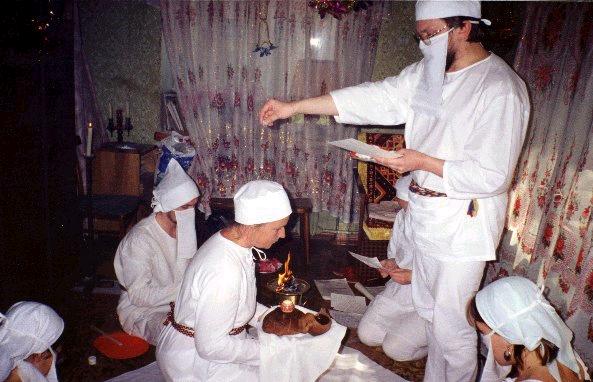
Sedreh Pushi of a group Russian converts to Zoroastrianism – Moscow, Russia (Source: CAIS).
A religious version of this argument claims that God Himself has placed everyone in his/her faith in a kind of religious destiny, and thus conversion is a disobedience against the God who has given you your specific religion. Many Zoroastrian traditionalists, especially Parsis, believe that the soul, which pre-exists birth into a material body, has chosen, in union with the will of God, to enter a specific religion. Attempting to convert is going against the true nature of one’s own Soul. For traditionalists, conversion to Zoroastrianism is just short of blasphemy – an act of contempt for the God who has given you birth in a specific tradition. It is true, the traditionalists admit, that many of the great faiths were originally built on conversions from other religions, but these early, founding conversions are justified because they were done under the inspiration of a true Prophet – such as Moses, Jesus, or Mohammed. Once the era of the Prophet is gone, then conversions again become invalid, for only a divine Prophet has the authority to convert people.
This leads to the conclusion that hundreds of millions of people are worshiping invalidly, because their ancestors, without the benefit of a Prophet, chose an alien faith – whether willingly or because of coercion. This includes numerous Iranians, who were originally Zoroastrian but were converted to Islam. The conservatives, though they are aware of this, still maintain that even an Iranian Muslim whose Zoroastrian ancestors were forcibly converted to Islam cannot return to the faith of his/her fathers. God, and those individual souls, chose that particular birth, no matter what went on historically. History cannot be reversed. Only a divine Prophet can convert people back to Zoroastrianism. Zoroastrian traditionalists rely on their religious beliefs about a coming Savior – the _saoshyant_- as a final answer to the problem of conversion. When the Savior arrives (a Zoroastrian idea that pre-dated Jewish Messianism and may have inspired the Jewish idea of the Messiah) this divine man will have the authority to convert people. Zoroastrians then hope that all people will be converted to Zoroastrianism through the power of the Savior, who will appear at the End of Time.
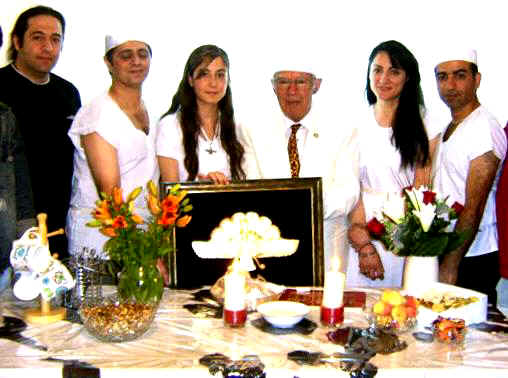
Sedreh Pushi of a group Iranian converts to Zoroastrianism by Dr Vandidad Golshani in London, United Kingdom (Source: CAIS).
Meanwhile, traditionalist Zoroastrians wait patiently and continue to oppose conversion to their ancient faith. The next reason they use to justify their opposition is political and cultural. When groups of Iranian pilgrims fled an oppressive Muslim regime in Iran in the 10th century AD, they came to Gujarat, a kingdom on the west coast of India. The Kisseh-i-Sanjan, an epic poem written by a 16th-century Parsi priest, documents the history of his people in India. According to the poem, the pilgrims negotiated with the rulers of Gujarat for safe haven there, and they worked out an agreement. The pilgrims were required to explain the tenets of their religion to the ruler; they were also to learn the local language and speak it rather than Persian. They were also required to adopt the dress of the area rather than wear Iranian garb, they were to celebrate their weddings in the evening rather than in the morning, and they were to put aside their weapons and not wear them at any time. Other traditions say that the Zoroastrian pilgrims were never to convert their Hindu or Muslim neighbors. This promise of non- conversion may not be documented in the poem or other surviving texts, but it is oral tradition, handed down in Zoroastrian culture for a thousand years and more. And the Parsis, as these pilgrims to India were called, have kept their promises. Thus the prohibition against conversion has a longstanding political background.
The social argument against conversion relies on the idea that Zoroastrianism is a strictly ethnic religion. In the traditionalists’ historical view, Zarathushtra was not an innovator, but a reformer who practiced the priestly traditions of his ancient Indo-Iranian people. Zoroastrianism, then, does not break traditions, but continues them – reformed from polytheism to monotheism by the divinely inspired Prophet. And these traditions are from time immemorial the exclusive possession of a people known as Aryans. In the West, the term “Aryan” has been permanently discredited by its misuse by the Nazis, and the more neutral “Indo-Iranian” is preferred. For a conservative Zoroastrian, especially those with a more extreme outlook, only those who are Indo-Iranian Zoroastrian, with an unbroken lineage unmixed with any non-Zoroastrian heritage, can be true Zoroastrians.
Proselytizing and conversion: Parsi Zoroastrians do not proselytize. In recent years, however, Zoroastrian communities in Iran, Europe and the Americas have been more tolerant towards conversion. While this move has not been supported officially by the priesthood in Mumbai, India, it has been endorsed by the Council of Mobeds in Tehran.
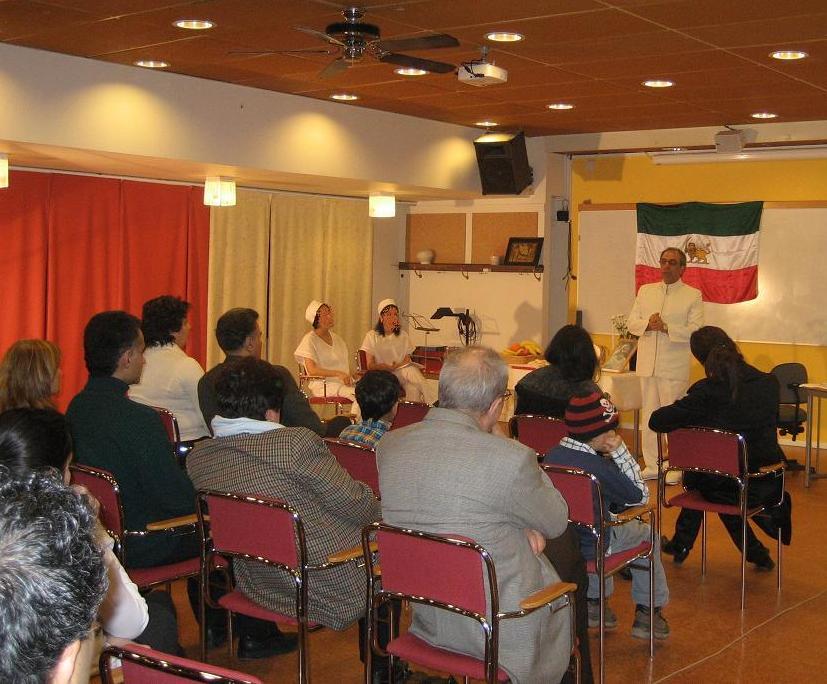
Sedreh Pushi of two Iranian converts in Stohkolm, Sweden (Source: CAIS).
Traditionalists regard Zoroastrianism as more than just a religion. It is an integral culture, which comprises not only faith and practice but an entire lifestyle: language, symbolism, law, clothing, calendar, festivals, food, family life, songs and literature, humor, history, etiquette, gestures, even interior decoration. This integral culture is learned from the earliest moments of life – transmitted from parents to children in an education that no school or sociological study could ever provide. In the traditionalist view, it is impossible to enter into this culture if you have not been born into it – you cannot learn as an adult things you should have learned along with your first steps and words. This culture, and the religion that goes with it, thus cannot be transferred. A non-Zoroastrian married to a Zoroastrian will always be at a loss to understand things his/her spouse takes for granted. And the non-Zoroastrian spouse will bring elements from his/her own culture that are alien to the Z. culture. It is better never to marry outside the culture, as conflict will always follow. The religion is a precious heirloom, which will only be misunderstood and adulterated by outsiders. In this view, intermarriage can only be seen as a threat, which will result in the dilution or even the extinction of the precious culture. And as Zoroastrians, both Iranian and Parsi, migrate away from their native countries, the immigrants are terrified, with good reason, that this heirloom culture will be swept away by the polluted ocean of “Western” culture which surrounds them. Modern culture is a deeply fearsome thing to many traditionalist Zoroastrians.
The third set of reasons that Zoroastrian traditionalists give for their opposition to conversion is emotional and psychological. Zoroastrianism, ever since the Muslim conquest of Iran, has been a minority religion. It has been persecuted in Iran for centuries. Even in India, where the Parsis lived more or less undisturbed by their hosts, the Zoroastrians have always remained separate from the majority. The main reason why these minorities have been able to survive through the centuries is because their religion gives them strength. Zoroastrianism has been the coherent core of the people, the rallying point that keeps them going through hard times, poverty, and persecution. Why, then, should it be given away to those who have not earned it, not suffered through the long years of trial? It would mean nothing to an outsider. And so conversion becomes meaningless, or even an insult.
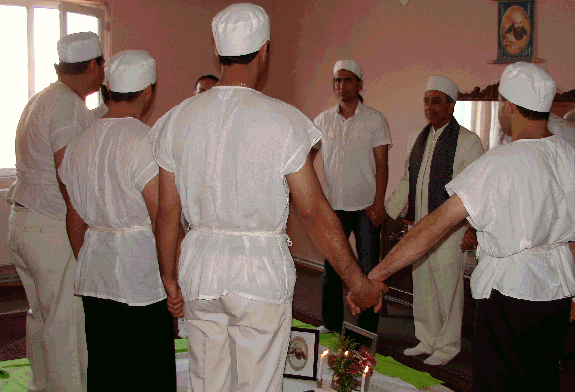
Sedreh-Pushi ceremony of a group of Turkish Kurds and Iranians in Istanbul who are recent converts to Zoroastrianism (Source: CAIS).
There seems to be a series of good arguments for banning conversion to Zoroastrianism. The trouble is that the number of “true” Zoroastrians continues to decrease. There are many reasons for this: a low birth rate, economic problems, the difficulty of finding qualified mates and raising families with a high standard of living, emigration, intermarriage, and simple apathy or ignorance of the faith. The resistance to any religious change has alienated many Zoroastrians, who question ancient laws and practices that they say were appropriate for the agrarian society of the past but have no relevance in a modern, technological world. If Zoroastrianism does not accept converts, say these questioners, it risks going the way of near-extinct sects such as the Shakers, whose inflexible practices (in the case of the Shakers, maintenance of celibacy and thus non- procreation) made it impossible to continue as a group.
It must be added that most of the anti-conversion sentiment in the Zoroastrian world comes from the Indian Parsis. Iranian Zoroastrians are much more likely to accept converts, marriages to non-Zoroastrians (who are then welcomed into the community) and people of mixed ancestry. The problems with conversion in Iran are mainly political: converting someone away from Islam is an offense against the Islamic Republic and may be seriously penalized. Therefore, conversions in Iran are done very quietly.
Since the late 1980s, new Zoroastrian congregations have been founded hroughout the world, including Brazil, Norway, Venezuela, Germany, Sweden, United Kingdom and the newly created republics of Central Asia. The yare mainly inspired by the missionary organization The Zarathushtrian Assembly, based in Los Angeles, California, and in line with Zoroaster’s original teachings, these congregations have, contrary to the Indian Zoroastrians which accept converts.
What arguments do the “liberal” Zoroastrians use to counter the conservatives? The liberal reformists claim documented history as their strongest argument in favor of conversion. According to the scriptures of Zoroastrianism, which range from the original Gathas of Zarathushtra to doctrinal works written in medieval times, conversion has not only been mentioned but accepted as a practice throughout the long history of the religion.
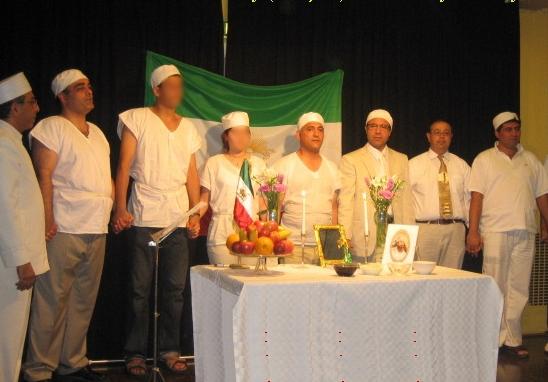
Sedreh Pushi of a group Iranian and Norwegian converts, Oslo, Norway (Source: CAIS).
There are many passages in the original hymns of Zarathushtra, the Gathas, where the Prophet explicitly claims a mission to convert all people – not just Indo-Iranians. References to conversion occur throughout the Avesta and even in the latest book of the Avesta, written about 200-400 AD, the Vendidad. Scholars both Western and Zoroastrian have written extensively on the spread of Zoroastrianism to Armenia, Central Asia, and as far east as China; other historical texts and archaeological studies prove that Zoroastrianism had spread, through Persian traders, as far west as Asia Minor, Syria, and possibly even Eastern Europe. In lands bordering Iran, many people became Zoroastrians who were not of Indo-Iranian ethnicity. Even after the Islamic conquest, Zoroastrianism was still open to converts, especially servants in Zoroastrian homes who were adopted into the faith by their employers. The strict ban on conversion only dates from the nineteenth century AD.
Notable converts to Zoroastrianism include Swedish artist and author Alexander Bard. and became one of the founders of the Swedish Zoroastrian congregation, currently the largest in Europe.
The textual and historical evidence provide a strong and convincing argument for conversion to Zoroastrianism. The traditionalists, faced with Zarathushtra’s clear references to converting all people, including non-Indo-Iranians, can only respond with the counter-argument that it is the TEACHINGS and IDEASof the Prophet that are intended for the whole world, while the RELIGION and its rituals belong only to the Indo-Iranian people. In other words, everyone can be inspired by Zarathushtra’s holy words, but only pure-bred Indo-Iranians can practice the actual religion of Zarathushtra. Another variant of this argument is that Zarathushtra’s references to a “universal” conversion only refer to a MORAL conversion from wrong-doing to right action, rather than a RELIGIOUS conversion from one faith to another. The more extreme traditionalists discount any conclusions or evidence provided by Western scholarship, regarding all Western interpretations of the Avesta scriptures as misguided, irreligious, and devoid of spiritual insight. Thus the Gathas, when considered as a separate text, are regarded by these traditionalists as a scholarly reconstruction, imposed by Western colonialists. For these extreme traditionalists, the entire Avesta, not just the Gathas, are the words of the Prophet, given by God, and its interpretation must be done in a spiritual and sometimes mystical fashion.

Sedreh Pushi of three Iranian converts in Dubai (Source: CAIS).
The “liberal” Zoroastrians are inspired by the text of the Gathas, which they regard as the only surviving words of the Prophet, and the primary text of the faith. They view Zarathushtra as a great innovator, rather than a reformer of a previous tradition. In the Gathas there is no mention of elaborate mythology, sacred time-schedules, coming Messiahs, Indo-Iranian exclusivity, priestly laws, or strict religious and ritual practices. The tone of the Gathas is philosophical, abstract, and ethical. The rituals, myths, and practices that the traditionalists are so intent on keeping, say the liberals, were DISCONTINUED by Zarathushtra, who never wanted them. It was only later that these religious and social elements were re-introduced into the religion. Therefore, say the reformers, there should be no objection to converting to Zoroastrianism, because the exclusive religious privileges of the Indo-Iranian people were never intended by Zarathushtra.



